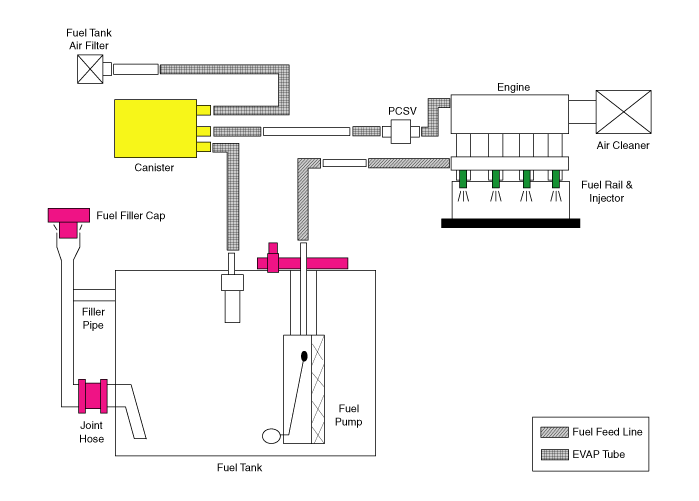Hyundai Tucson: Evaporative Emission Control System - Description
Description
The Evaporative Emission Control System prevents fuel vapor stored in fuel tank from vaporizing into the atmosphere. When the fuel evaporates in the fuel tank, the vapor passes through vent hoses or tubes to a canister filled with charcoal.
The canister temporarily holds the vapor in the charcoal. The ECM will control the system in order to draw the gathered vapor into the combustion chambers during certain operating conditions. Engine manifold vacuum is used to draw the vapor into intake manifold.
Schematic Diagram

Canister
The Canister is filled with charcoal and absorbs evaporated fuel vapor from the fuel tank. The gathered fuel vapor in canister is drawn into the intake manifold by the ECM/PCM when appropriate conditions are set.
Purge Control Solenoid Valve (PCSV)
The Purge control solenoid valve (PCSV) is installed in the passage connecting the canister to the intake manifold. It is a duty type solenoid valve and is operated by ECM/PCM signal.
To draw the absorbed vapor into the intake manifold, the ECM/PCM will open the PCSV, otherwise the passage remains closed.
Fuel Filler Cap
A ratchet tightening device in the threaded fuel filler cap reduces the chances of incorrect installation, when sealing the fuel filler. After the gasket on the fuel filler cap and the fill neck flange make contact, the ratchet produces a loud clicking noise indicating the seal has been set.
READ NEXT:
 Evaporative Emission Control System - Removal
Evaporative Emission Control System - Removal
Removal
WARNING
Be careful not to damage the parts located under the vehicle (floor
under cover, canister, fuel tank)
when raising the vehicle using the lift.
(Refer to General Information - "Lift and Support Points")
Turn
 Evaporative Emission Control System- Installation
Evaporative Emission Control System- Installation
Install in the reverse order of removal.
Inspection
Check for the following items visually.
Cracks or leakage of the canister
Loose connection, distortion, or damage of the vapor hose/tube
Canister→ Atmosphere
Caniste
SEE MORE:
 Fuel Filler Door
Fuel Filler Door
Component Location
Fuel filler door release actuator
Inspection
Disconnect the negative (-) battery terminal.
Remove the fuel filler housing after opening the fuel filler door.
(Refer to Body - "Fuel Filler Door")
Dis
 Power Relay (Type A)
Power Relay (Type A)
Component Location
Engine room junction block
ICU Junction block
Inspection
Power Relay (Type A)
There should be continuity between the No.30 and No.87 terminals when
power and ground are
connected to the No.85 and No.86
Information
- Home
- Hyundai Tucson - Fourth generation (NX4) - (2020-2023) - Owner's Manual
- Hyundai Tucson - Fourth generation (NX4) - (2020-2023) - Workshop Manual